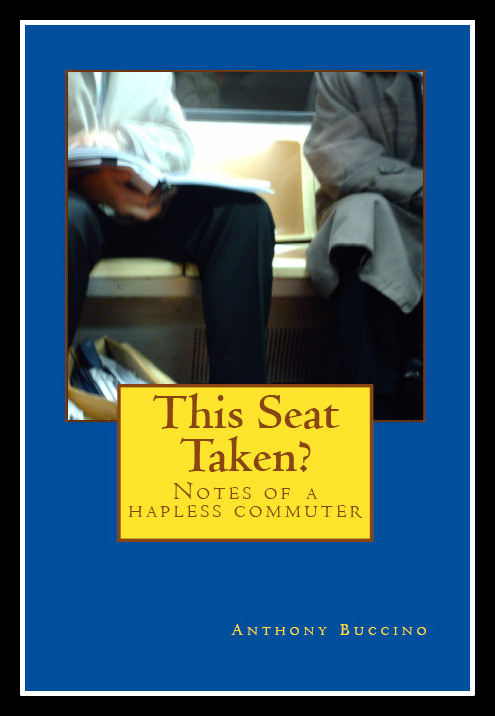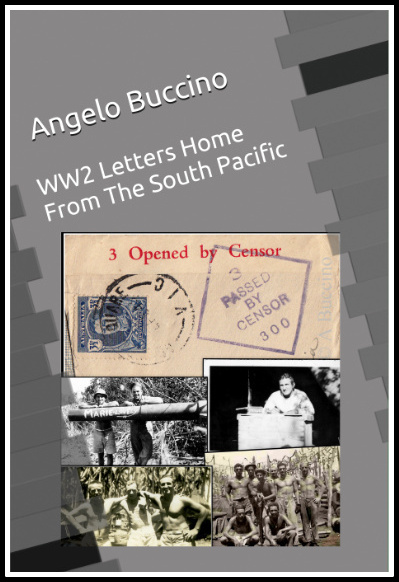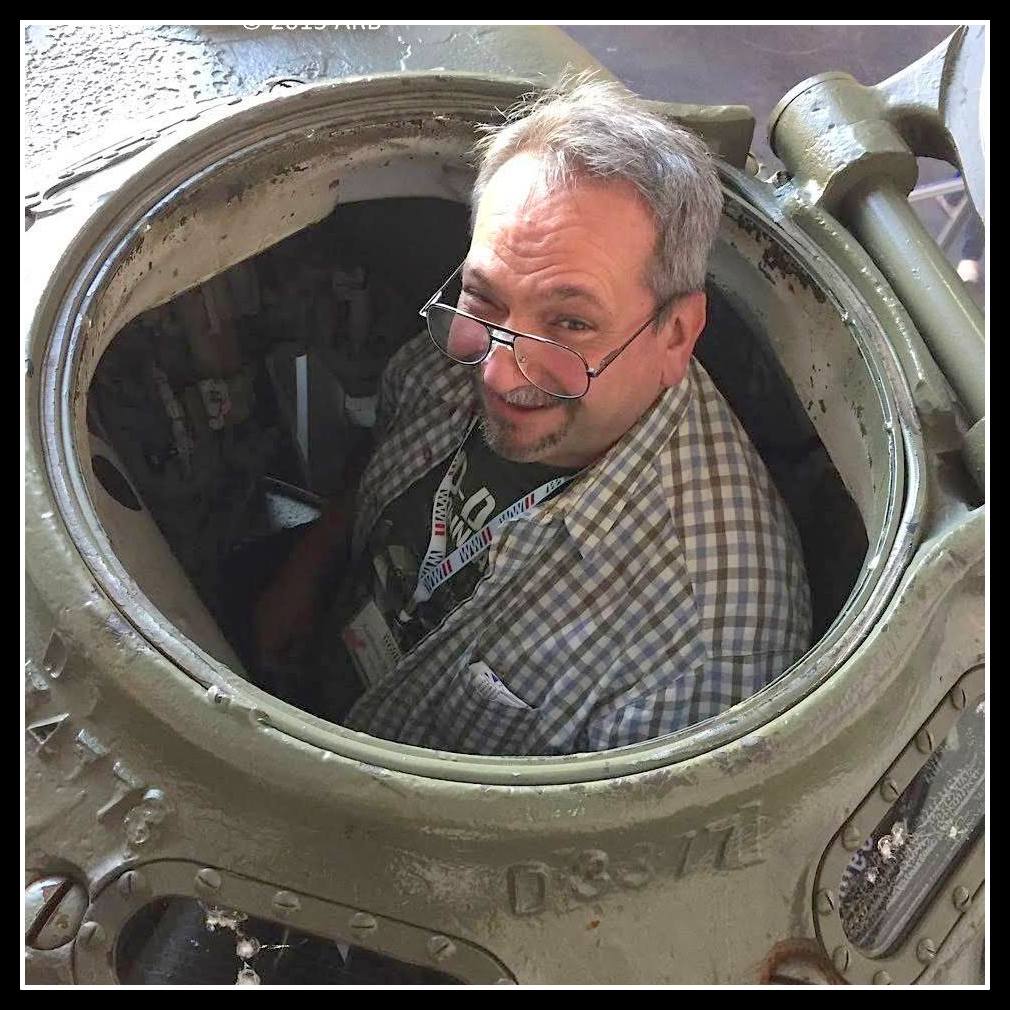 I sit in the commander seat. The five-man crew is a loader, gunner, driver and
assistant driver. Tankers are known to carry a sidearm in case of a Zippo event
(lights on first strike). I sit in the commander seat. The five-man crew is a loader, gunner, driver and
assistant driver. Tankers are known to carry a sidearm in case of a Zippo event
(lights on first strike).
NEW ORLEANS
— I’m
peering through this periscope to the outside world. Out of my
view, three dozen sandbags are piled on the front of Draftee, my
Sherman tank. If a German armor-piercing shell hits us, the
sandbags will take some of the sizzle and thwart the damage.
Otherwise, the tip of that shell will superheat our armor, rip
through this tin can, ignite our arsenal, kill our crew, and exit
our backside to take out the tank behind us in formation. Our tanks
are nicknamed Zippo because they light on first strike from a German
shell.
We lose far too many of our number in tank-on-tank battles. Our
tactics change as the war wears on.
Our main gun fires 75 mm shells with a
muzzle velocity of 2,030 feet per second. That’s not enough to stop
most Kraut tanks
— the
Panzer, Tiger, or Panther
—
unless we are in close range and hit them in a weak spot, their side
or rear.
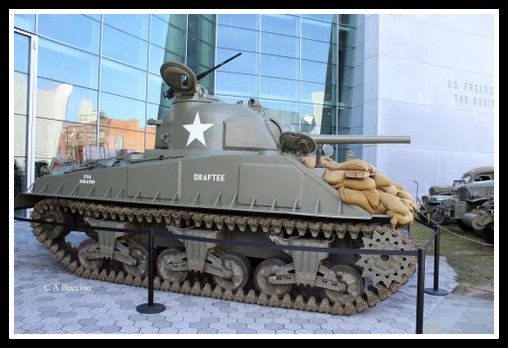
Restored and on display WWII Sherman tank, Draftee, donated by the
West Bank Optimist Club at the National WWII Museum in New Orleans,
La.
Without crew and ammo, Draftee weighs 66,700 lbs. Our V8 engine
kicks up 500 horsepower, and has a level ground sustained speed of
26 miles per hour. We burn gasoline but don’t get too far on a
gallon, maybe five miles or so. Draftee is one of 1,690 M4 A3
Sherman tanks built and delivered in 1943 by Ford Motor, Highland
Park, Mich.
Our infantry support tank is designed with breakthrough striking
capacity to breach opposing skirmish lines. As tanks go, we’re
lightweights and built for speed. We can blow up most things in our
way except those Kraut tanks. This baby has a 30-caliber Browning
machine gun firing through a gap in the sandbags. Our top-mounted
50-caliber Browning machine gun is for cleaning up.
I sit in the commander seat. The five-man crew is a loader, gunner,
driver and assistant driver. Tankers are known to carry a sidearm in
case of a Zippo event (lights on first strike). These seats around me are empty save for the
spirit of the men who rode this beast, the men who saved the world.
The war is more than seventy years gone
and I am a civilian immersed in World War II. This Draftee smells of
fresh paint and grease but not gun powder. My battle station inside
this restored, drivable WWII Sherman tank
—
donated by the West Bank Optimist Club
—
is the highlight of my daylong tour at the National World War II
Museum in New Orleans.
Docent Ronnie Abboud stresses the museum and artifacts are “not
about things,” this place, in the Louisiana Memorial Pavilion, this
sacred place is about stories, the stories of the men and women who
won the war and literally saved the world. Guys like my father who
served at Guadalcanal in the South Pacific.
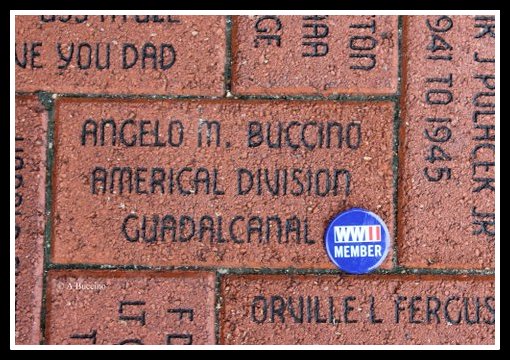
Paver purchased to honor a veteran of Guadalcanal and support the
museum expansion.
Our tour began in the original D-Day Museum building at a restored
Higgins Boat. In Army parlance, that’s the Landing Craft Personnel (LCPV).
These are the small boats that carried troops, about 30 at a clip,
and equipment, from the large ships to Normandy beaches on D-Day.
New Orleans-based boat builder Andrew
Higgins adapted the LCPV from the shallow-draft boats he built for
use in the area marshes. His company employed about 5,000 people in
town
— men,
women, black and white
— so
unusual in the South in the early 1940s
—
worked side-by-side in the war effort.
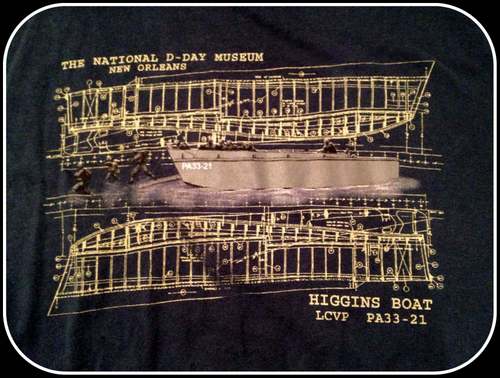
In 1964, Dwight D. Eisenhower told historian Stephen Ambrose:
“[Andrew Higgins] is the man who won the war for us. If Higgins had
not designed and built those landing craft, we never would have
landed over an open beach. The whole strategy of the war would have
been different.”
A University of New Orleans history professor, Ambrose was a
biographer of U.S. Presidents Eisenhower and Richard Nixon. Ambrose
wrote several best-selling books about World War II and the Normandy
invasion, including the book on which the 10-part Band of Brothers
TV film series is based.
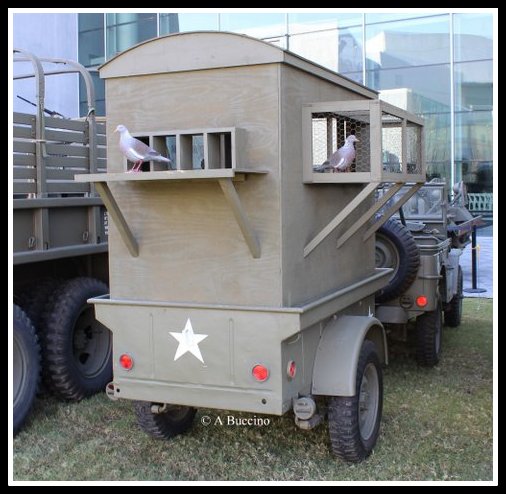
Restored WWII mobile homing pigeon carrier. Vehicles were moved
outside U.S. Freedom Pavilion: The Boeing Center due to the
Veterans’ Day Ceremony.
Museum founder Ambrose cited Higgins’ contribution to the war effort
as one reason to build the D-Day Museum here. The Louisiana pavilion
on Magazine Street is where the initial museum opened June 6, 2000.
Ambrose died two years after its completion, but was aware of
efforts to tell the full war story through added pavilions as the
National World War II Museum. Congress designated it as the official
WWII museum of the U.S.
In the Louisiana Memorial Pavilion, Abboud leads our small group on
this special tour as we course through the Home Front and European
Theater of Operations. The Fortress Europe theater seems dated now
with its smallish displays of Normandy Beach, French hedgerows,
uniforms worn by both Allied and Axis armies’ soldiers, small arms,
ammo, mortars and heavy weapons.
This display is supplanted in the new, much larger, Campaigns of
Courage Pavilion: Road to Berlin, one of five buildings in the $300
million museum expansion.
In the Road to Berlin: European Theater
Galleries visitors learn more details, hear more stories
—
including many first-hand accounts
—
than the initial D-Day Museum could hold. One display includes a
snow-covered, splintered pine tree to represent the Battle of the
Bulge and the siege of Bastogne. The second floor exhibit Road to
Tokyo opened in December.
I wanted to tour the Sherman tank on
display in the U.S. Freedom Pavilion: The Boeing Center. The old
tank shares an atrium with a bomber
—
suspended from the ceiling
—
reclaimed and restored from its crash site in Greenland,
half-tracks, trucks, a smaller tank, and the mobile homing pigeon
coop.
As part of our exclusive tour, we amble up a step ladder to the tank
deck and prepare to enter the commander’s hatch. The steel deck
throws many obstacles at our feet: air ducts, rings, and footholds
the crew probably never used. We tread cautiously.
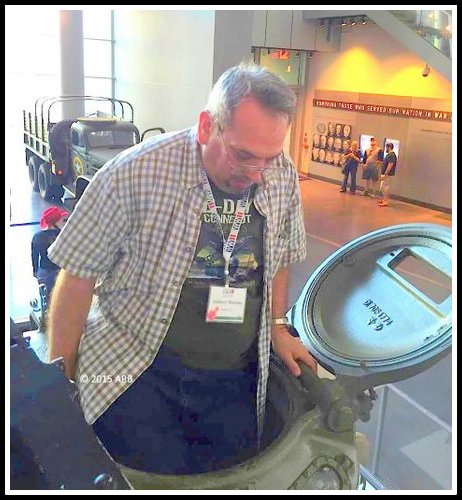
Inside U.S. Freedom Pavilion: The Boeing Center. “It sure looks a
lot easier in the movies!” Photo by Tom Askins.
When it comes my turn to climb in, I look for something nearby to
grab and try to raise my leg over and into the hatch. My leg doesn’t
want to bend. I am not a 20-year-old soldier, it tells me. My days
of playing Army are long gone. But I reach down and grab the hem of
my jeans and pull it up and get my foot clear of the rim, then peer
in seeking a step finally alighting on the turret seat. Then I ease
down the other leg. I see the gunner’s seat a bit below and step
down onto that.
In the few minutes I actually sit, stand, (really, as who had time
to get comfortable,) inside Draftee, I imagine what the crew saw,
the things they’d done, and the lives they returned to after the
fighting.
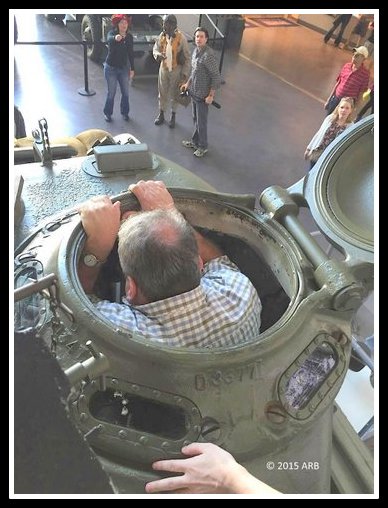
This Sherman tank is much higher when you look down from the top.
See everyone amazed at the old man climbing in, or out. Photo by Tom
Askins.
Had I been forty years younger I could have maneuvered inside. It
seems quite possible in the films I’ve seen. However, once inside,
all I manage is a quick look around. Pedals, levers, gear shifts,
and many things curator Brandon Stephens warned me not to touch. He
also warned that, yes he could help me in, but if I got stuck, we’d
all be in trouble.
Here’s to the men who drove these tin cans into battle and faced
superior odds with grit, determination and their lives to save the
free world.
Those fellows operating these beasts must have been quite short, I
muse aloud. Stephens says one top tank crewman was 6-foot 2-inches
and 240 pounds. Must have been all muscle! I decide to climb out as
soon as I can breathe normally. A guy could get stuck in a time warp
here.
First Published July 17, 2016 on
Medium.com
Copyright © Anthony Buccino
Read more:
Travels With Tonoose
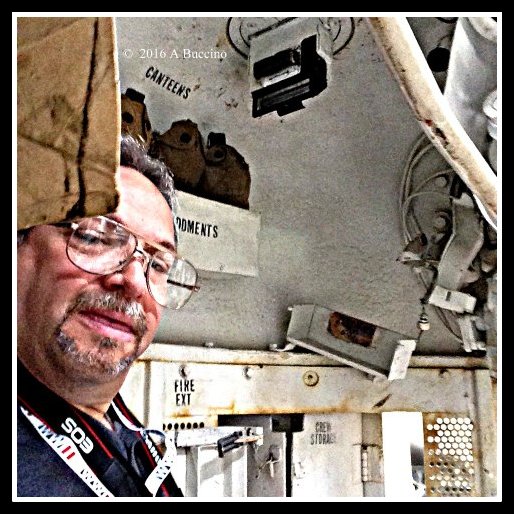
Selfie sitting on the
floor inside restored WW2 Sherman Tank 'Draftee' at National WW2
Museum, New Orleans. It both is and isn't as cramped as it looks.
Behind the Lines Tour - The National WW2 Museum
New Orleans: Enjoying a Big Easy
Pace of Life
Tanks for the Memories - Last Man Standing
Death Traps: The Survival of an American Armored Division in World
War II by Belton Y. Cooper
World War II - Recommended Reading
Cherry
Blossom Press

Photography

Photo Books
Photo
Galleries
Nutley, NJ, Books
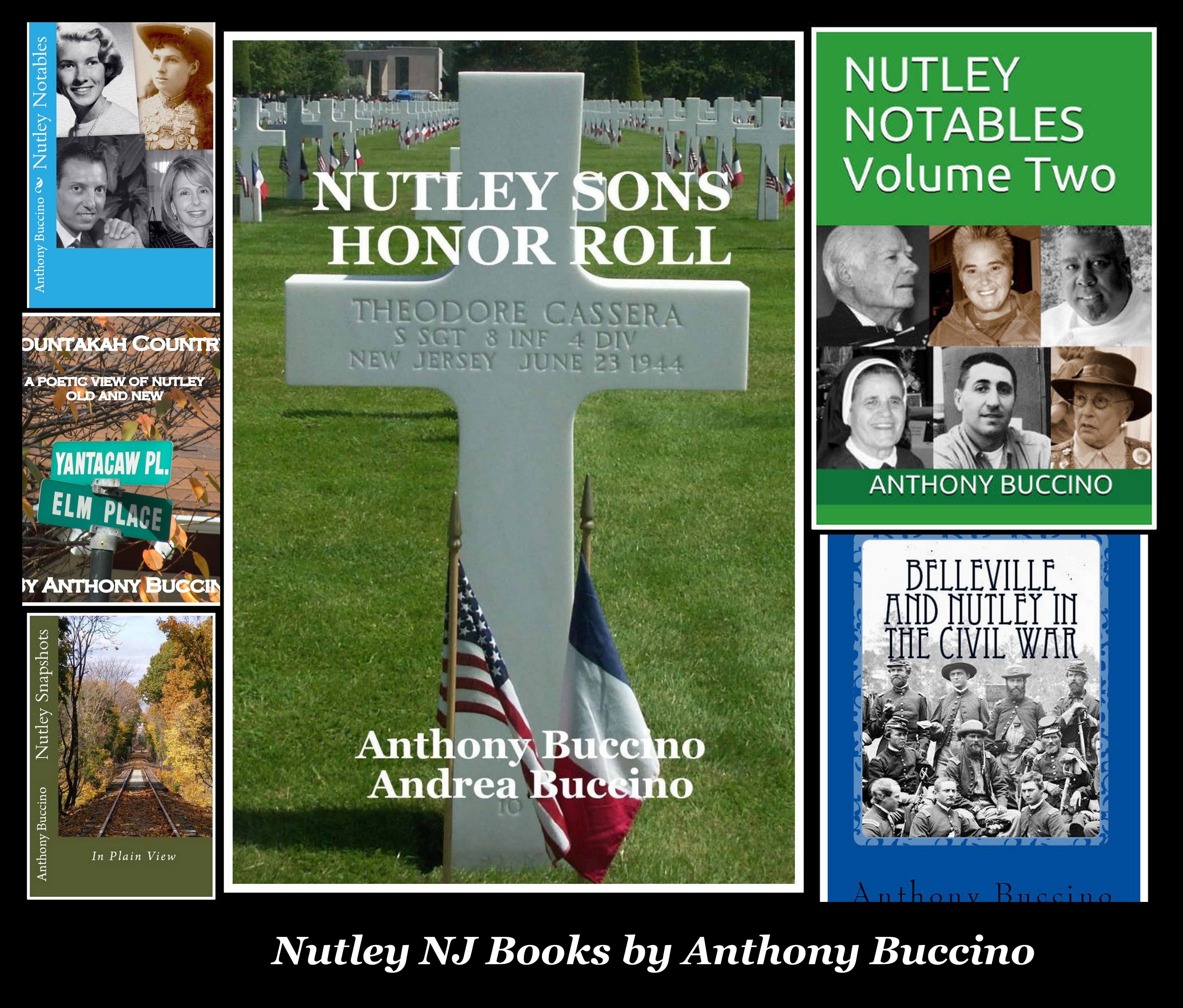
Belleville, NJ, Books

Military History
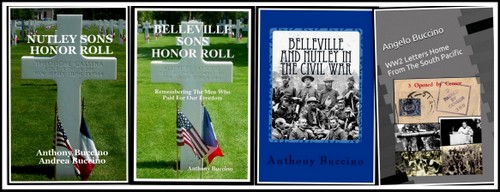
Poetry Collections

|

















